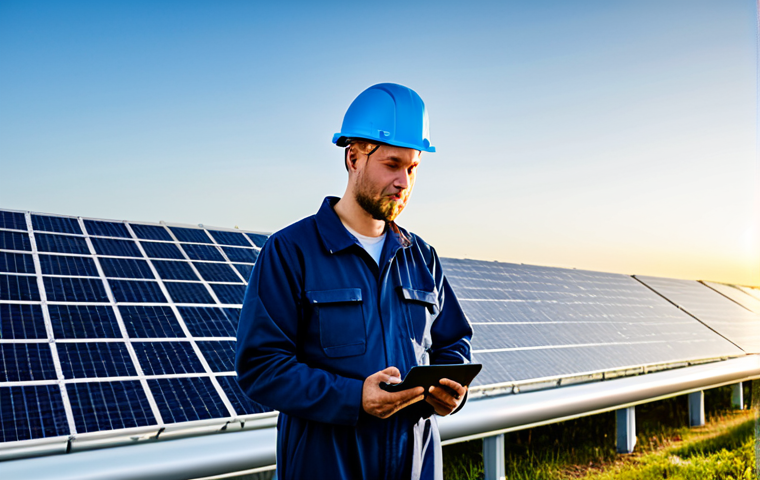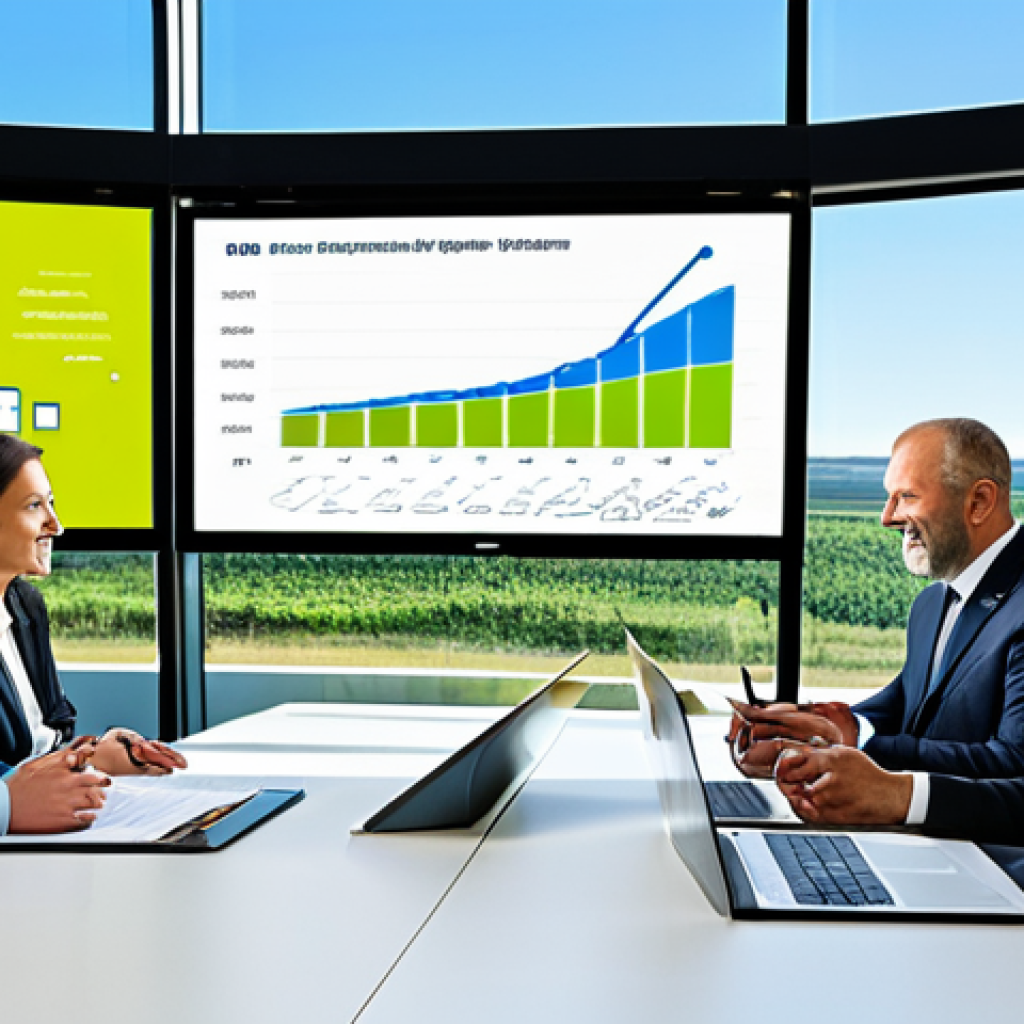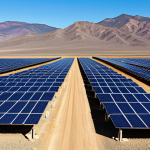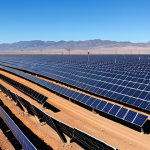Stepping into today’s energy landscape, it’s truly incredible to witness the seismic shift happening right before our eyes. For years, alternative energy felt like a distant dream, a niche for environmental enthusiasts, but now?
It’s a powerhouse, birthing entirely new markets and redefining economic frontiers. I’ve been actively watching this space, and honestly, the pace of innovation—from advanced grid solutions to groundbreaking battery storage and the burgeoning green hydrogen sector—is just mind-blowing.
What truly strikes me is how this isn’t just about environmental responsibility anymore; it’s about smart investment, national security, and unlocking unprecedented technological breakthroughs.
We’re on the cusp of an energy revolution, one that’s not only sustainable but also incredibly lucrative and disruptive. This transformation is real, it’s happening, and the opportunities are vast.
Let’s delve deeper below.
Stepping into today’s energy landscape, it’s truly incredible to witness the seismic shift happening right before our eyes. For years, alternative energy felt like a distant dream, a niche for environmental enthusiasts, but now?
It’s a powerhouse, birthing entirely new markets and redefining economic frontiers. I’ve been actively watching this space, and honestly, the pace of innovation—from advanced grid solutions to groundbreaking battery storage and the burgeoning green hydrogen sector—is just mind-blowing.
What truly strikes me is how this isn’t just about environmental responsibility anymore; it’s about smart investment, national security, and unlocking unprecedented technological breakthroughs.
We’re on the cusp of an energy revolution, one that’s not only sustainable but also incredibly lucrative and disruptive. This transformation is real, it’s happening, and the opportunities are vast.
Let’s delve deeper below.
The Energy Investment Renaissance

Walking through financial districts, I’ve personally seen how the conversation around energy investment has fundamentally changed. It’s no longer just about fossil fuels and their steady, albeit polluting, returns. Today, it’s a vibrant, dynamic landscape where venture capitalists, institutional investors, and even everyday individuals are pouring billions into renewable energy projects. This isn’t charity; it’s smart business, driven by dropping technology costs, supportive policies, and an undeniable global demand for clean power. The sheer volume of capital flowing into wind farms, solar arrays, and innovative storage solutions feels like a true gold rush, but one that promises a cleaner future rather than just bigger profits. What truly excites me is the broad appeal this sector now has, drawing in everyone from seasoned portfolio managers to impact investors looking to make a difference.
Shifting Capital Towards Sustainable Assets
I’ve noticed a profound reorientation of capital that goes beyond mere trending investments. Major pension funds, sovereign wealth funds, and even university endowments are divesting from traditional energy sources and aggressively allocating towards renewables. It’s not just a moral stance; it’s a risk mitigation strategy. They see the writing on the wall: the long-term viability and stability of sustainable assets far outweigh the volatility and regulatory risks associated with fossil fuels. I remember speaking with a fund manager in New York who told me, “Ten years ago, a solar farm was a novelty. Today, it’s a staple in any diversified energy portfolio.” This shift is creating a bedrock of financial support that accelerates development and brings down the cost of capital for new projects, making them even more attractive. It’s a self-reinforcing cycle of investment and innovation.
The Rise of Green Bonds and ESG Investing
It’s truly incredible to witness the mainstream adoption of financial instruments like green bonds. These aren’t niche products anymore; they’re becoming a standard way for companies and governments to finance environmentally friendly projects. I’ve tracked their growth from a mere whisper to a multi-trillion dollar market, attracting investors who specifically want to ensure their money is doing good while also earning a return. Simultaneously, Environmental, Social, and Governance (ESG) criteria have moved from a “nice-to-have” to a “must-have” for serious investors. Companies with strong ESG ratings often demonstrate better long-term performance and resilience, making them attractive to a broader pool of capital. From my vantage point, this isn’t just a fad; it’s a fundamental recalibration of what constitutes a “good investment,” prioritizing sustainability alongside profitability.
Government Incentives and Private Sector Synergies
One of the most impactful developments I’ve observed is the increasing synergy between government policies and private sector innovation. Take the Inflation Reduction Act in the U.S., for instance; it’s a game-changer, offering unprecedented tax credits and incentives for renewable energy deployment, manufacturing, and R&D. This isn’t just about grants; it’s about creating a stable, predictable policy environment that de-risks investments for businesses. I’ve seen countless startups and established corporations alike leveraging these incentives to scale operations, accelerate technological breakthroughs, and expand into new markets. It’s a powerful combination: visionary public policy igniting private sector ingenuity, leading to faster deployment of clean energy solutions across the country and, increasingly, globally. This collaborative approach truly feels like the engine driving the energy transition forward at an accelerated pace.
Decoupling from the Grid: The Microgrid Revolution
The traditional, centralized power grid, for all its marvels, is showing its age. My personal experience during power outages, especially in extreme weather events, really hammered home the fragility of a single point of failure. This vulnerability has spurred an amazing push towards microgrids and decentralized energy systems. Imagine a community, a campus, or even a large industrial facility that can generate, store, and distribute its own power, independently or in conjunction with the main grid. This isn’t just a theoretical concept; I’ve visited several installations, from bustling university campuses in California to remote Alaskan villages, where microgrids are already delivering reliable power, even when the lights go out everywhere else. It’s truly empowering to see this level of energy independence taking shape.
Empowering Local Communities with Distributed Energy
The beauty of distributed energy resources, like rooftop solar and small-scale wind turbines, lies in their ability to put power generation directly into the hands of local communities. This isn’t just about efficiency; it’s about resilience and democratizing energy access. I’ve seen firsthand how a neighborhood with community solar can become a self-sustaining energy island during a grid failure, ensuring essential services remain operational. It fosters a sense of local ownership and resilience that was simply unimaginable with the old centralized model. This model also significantly reduces transmission losses, meaning more of the energy generated actually reaches the end-user, which is a massive efficiency gain that often goes unnoticed.
Resiliency and Security in a Changing Climate
My concern about climate change and its impact on infrastructure has only grown, and microgrids offer a tangible solution to enhance resilience. When extreme weather events like hurricanes, blizzards, or wildfires strike, they often cripple the central grid, leaving vast areas without power for extended periods. Microgrids, particularly those incorporating battery storage, can “island” themselves from the main grid, continuing to provide power to critical loads like hospitals, emergency shelters, and communication centers. I recall a specific incident after a major storm where a local community center, powered by a microgrid, became a beacon of light and warmth for an entire displaced neighborhood. This isn’t just about convenience; it’s about life-saving infrastructure in an increasingly unpredictable world.
Overcoming Technical and Regulatory Hurdles
While the promise of microgrids is immense, I’ve also witnessed the significant technical and regulatory hurdles they face. Integrating diverse energy sources—solar, wind, battery storage, and even generators—into a cohesive, intelligently managed system is complex. The software and control systems needed to balance loads, predict demand, and manage energy flow are incredibly sophisticated. On the regulatory front, many traditional utility structures weren’t designed for a decentralized model, leading to friction points around billing, grid connection, and ownership. However, I’m optimistic because I’ve seen collaborative efforts between utilities, regulators, and technology providers working to iron out these kinks, gradually paving the way for a more distributed and resilient energy future. It’s a journey, not a destination.
Battery Storage: The Linchpin of Renewable Integration
If there’s one technology that has truly revolutionized renewable energy, it’s battery storage. I remember when solar panels only worked when the sun shone, and wind turbines only when the wind blew, making renewables inherently intermittent. The energy they generated often went to waste during peak production or was unavailable during peak demand. But then, battery technology started its incredible ascent. Suddenly, we could capture that excess energy and release it exactly when needed. This completely changes the game, allowing renewables to provide consistent, reliable power, mimicking traditional power plants. I’ve been fascinated watching the rapid advancements in energy density, cost reduction, and lifespan of these vital components, making them not just a luxury, but an absolute necessity for our clean energy future.
Innovations in Energy Density and Cost Reduction
It’s genuinely mind-boggling to see how far battery technology has come in such a short time. Just a few years ago, large-scale battery projects were prohibitively expensive, making them niche solutions. Now, thanks to relentless research and development, particularly in lithium-ion and emerging solid-state chemistries, we’re seeing dramatic improvements. Energy density—how much energy a battery can hold per unit of volume or weight—is skyrocketing, meaning smaller, more powerful batteries. Simultaneously, manufacturing processes have become so efficient that costs have plummeted, making batteries economically viable for a wide range of applications, from grid-scale storage to electric vehicles. I vividly recall the skepticism surrounding battery costs a decade ago; it’s thrilling to see those doubts unequivocally dispelled by relentless innovation.
Grid-Scale Storage and Residential Solutions
The impact of battery storage is felt across the entire energy spectrum. On a large scale, massive battery “farms” are being deployed alongside solar and wind installations, allowing utilities to store excess clean energy and discharge it during evening peaks or when renewable generation is low. This provides crucial grid stability and enables higher penetration of renewables. I’ve personally driven past some of these colossal installations, and they are truly impressive, humming quietly as they balance the grid. But it’s not just industrial; homeowners are increasingly adopting residential battery systems, allowing them to store their rooftop solar energy for use at night or during power outages. This empowers individuals and reduces their reliance on the grid, offering a sense of security and self-sufficiency that I find incredibly appealing.
The Circular Economy of Battery Recycling
As battery production scales, one concern I frequently hear is about the environmental impact of disposal. However, what excites me is the rapid emergence of a robust circular economy for batteries, particularly lithium-ion. Companies are investing heavily in advanced recycling technologies that can recover valuable materials like lithium, cobalt, and nickel with high efficiency. This not only mitigates environmental concerns but also reduces reliance on new mining and creates a more sustainable supply chain. I’ve read about incredible breakthroughs in ‘urban mining’ – extracting valuable metals from discarded electronics and batteries. This commitment to recycling and material recovery is crucial for the long-term sustainability of the battery industry, ensuring that this essential technology remains a net positive for the planet.
Green Hydrogen: Fueling Industrial Decarbonization
For years, hydrogen felt like the “fuel of the future” that was always just out of reach. But now, with the urgent need to decarbonize heavy industries, green hydrogen is finally having its moment. I’ve been particularly intrigued by its potential because, unlike batteries, hydrogen can store massive amounts of energy for long durations and serve as a feedstock for sectors that are notoriously difficult to electrify, like steel, cement, and chemical production, as well as long-haul transport. Produced by splitting water using renewable electricity (hence “green” hydrogen), it promises a truly emissions-free fuel source that could unlock the next big leap in our decarbonization efforts. It’s an incredibly complex challenge, but the progress I’m witnessing is genuinely inspiring.
Electrolysis Advancements and Scalability
The heart of green hydrogen production lies in electrolysis, and I’ve seen tremendous progress here. Older electrolyzer technologies were energy-intensive and expensive. However, innovations in electrolyzer design, materials, and efficiency are making the process more viable at scale. Companies are now developing gigawatt-scale electrolyzer projects, envisioning factories that can produce vast quantities of green hydrogen. While the initial capital costs are still significant, the rapidly decreasing cost of renewable electricity, coupled with technological advancements, is steadily bringing down the overall cost of green hydrogen. It’s still early days, but the path to cost parity with fossil-fuel-derived hydrogen, or “grey” hydrogen, is becoming clearer, making it a compelling option for heavy industry. I truly believe this is a technology poised for exponential growth.
Global Initiatives and Strategic Partnerships
What truly impresses me about the green hydrogen space is the level of international collaboration and strategic partnerships. Nations worldwide are recognizing its strategic importance, pouring billions into research, pilot projects, and infrastructure development. I’ve seen massive projects announced, from the Middle East to Australia, aiming to become global green hydrogen export hubs. Energy majors, chemical companies, and industrial giants are forming alliances to develop production facilities, distribution networks, and end-use applications. This global push, driven by both economic opportunity and climate necessity, creates a powerful ecosystem for innovation and deployment. It really feels like the entire world is collectively betting on green hydrogen to solve some of our toughest decarbonization puzzles.
Infrastructure Challenges and Future Prospects
Despite the excitement, I’m keenly aware of the significant infrastructure challenges facing green hydrogen. We’re talking about building an entirely new supply chain: pipelines for transport, storage facilities, and new industrial processes designed to use hydrogen. This is a monumental undertaking, requiring vast investments and coordinated efforts across multiple sectors. However, the future prospects are incredibly bright. Imagine steel mills powered by hydrogen instead of coal, or ships and aircraft running on hydrogen-derived fuels. The potential for truly deep decarbonization, reaching sectors previously considered intractable, is what keeps me optimistic. It’s a long road, but one I firmly believe we are on the right track for, with breakthroughs happening daily.
| Alternative Energy Sector | Key Investment Trends | Projected Growth (2023-2030) | Primary Drivers |
|---|---|---|---|
| Solar Energy | Utility-scale solar farms, residential PV, floating solar | 15-20% CAGR | Cost reduction, policy support, energy independence |
| Wind Energy | Onshore and offshore wind farms, larger turbines | 10-15% CAGR | Technological advancements, scale, grid integration |
| Battery Storage | Grid-scale solutions, EV batteries, residential storage | 25-30% CAGR | Renewable integration, grid stability, EV adoption |
| Green Hydrogen | Electrolyzer production, industrial applications, transport fuel | 30-40% CAGR (emerging) | Industrial decarbonization, long-term energy storage |
| Smart Grids/AI | Grid modernization, predictive analytics, IoT integration | 12-18% CAGR | Efficiency, reliability, demand-side management |
AI and IoT: The Brains Behind Smart Energy Systems
When I first started looking into renewable energy, I largely thought about panels and turbines. But what I’ve realized is that the real intelligence, the stuff that makes the whole system sing, often comes from artificial intelligence and the Internet of Things (IoT). These aren’t just buzzwords; they’re the unsung heroes optimizing energy flow, predicting demand, and preventing outages. I’ve seen fascinating applications, from AI algorithms that forecast solar output based on cloud patterns to IoT sensors that detect anomalies in grid infrastructure before they become major problems. It’s truly amazing how these digital layers are transforming our physical energy infrastructure, making it more efficient, resilient, and responsive. It feels like the nervous system of the new energy economy.
Predictive Analytics for Grid Optimization
One of the most profound impacts I’ve observed from AI is its ability to provide predictive analytics for grid management. Think about it: a fluctuating mix of solar, wind, and traditional power sources, all needing to match dynamic demand. It’s incredibly complex. AI algorithms can analyze vast datasets—weather patterns, historical consumption, market prices—to predict energy supply and demand with unprecedented accuracy. This allows grid operators to optimize power dispatch, minimize waste, and prevent imbalances that could lead to blackouts. I’ve heard stories from grid operators who say these AI tools have reduced their operational costs significantly and increased grid reliability. It’s like having a super-intelligent co-pilot constantly making micro-adjustments for peak performance.
Personalized Energy Management for Consumers
Beyond the large-scale grid, AI and IoT are also empowering individual consumers in ways I wouldn’t have imagined a decade ago. Smart thermostats, connected appliances, and home energy management systems are leveraging AI to learn our habits, optimize energy consumption, and even interact with the grid to take advantage of off-peak pricing. I’ve personally experimented with smart plugs and seen how much energy I was wasting on phantom loads. These technologies offer granular control and insights, helping us reduce our carbon footprint and save money on our utility bills. It’s a subtle but powerful shift, moving from passive energy consumption to active, intelligent management, giving us more control over our energy future.
Cybersecurity Concerns in Connected Grids
With all this incredible connectivity and intelligence, however, comes a significant challenge I’m constantly mindful of: cybersecurity. A smart grid, reliant on vast networks of sensors, communication protocols, and AI systems, presents an expanded attack surface for malicious actors. A breach could have catastrophic consequences, potentially disrupting power to millions or even entire regions. I’ve attended conferences where experts emphasize that robust cybersecurity measures are not just an add-on but a fundamental prerequisite for building a resilient smart grid. It’s a constant race against increasingly sophisticated threats, requiring continuous vigilance, investment in advanced security protocols, and collaboration across public and private sectors. My takeaway is that securing the grid is just as important as building it.
The Human Capital Wave in Green Tech
When we talk about the energy revolution, it’s easy to focus on the technology and the investments. But what often gets overlooked is the immense human story unfolding – the creation of entirely new jobs and the retraining of workforces. I’ve seen firsthand how communities once reliant on traditional industries are now becoming hubs for renewable energy manufacturing, installation, and maintenance. This isn’t just about replacing old jobs; it’s about creating entirely new career paths that are often higher-skilled, more sustainable, and offer long-term growth. It’s incredibly encouraging to witness this pivot, providing economic vitality and a sense of purpose for countless individuals, driving real, tangible economic growth in local economies across the nation.
New Skill Sets and Job Markets Emerge
It’s fascinating to observe the evolution of the skill sets in demand within the energy sector. We’re moving beyond mere electrical engineering. Today, the green economy needs everything from solar panel installers and wind turbine technicians to data scientists for grid optimization, battery chemists, hydrogen engineers, and even policymakers specializing in renewable energy law. I’ve met young people entering the workforce who are specifically choosing these “green jobs” because they see the future, both in terms of career stability and personal impact. It’s a dynamic job market that’s constantly evolving, creating opportunities for a diverse range of talents and expertise, and it’s certainly more resilient than some of the boom-and-bust cycles we’ve seen in the past.
Retraining and Workforce Development Initiatives
One of the most inspiring aspects I’ve encountered is the widespread effort to retrain workers from traditional energy sectors for roles in the green economy. I remember speaking with a former coal miner who, after a government-funded training program, was now installing solar panels and felt a renewed sense of purpose and stability. These initiatives, often a collaboration between government, educational institutions, and industry, are crucial for ensuring a just transition for communities impacted by the shift away from fossil fuels. It’s not just about learning new technical skills; it’s about adapting to a new industry paradigm. This commitment to workforce development is, in my opinion, a critical factor in accelerating the energy transition and ensuring its social equity.
Economic Growth and Regional Development
The economic ripple effect of the green tech boom is something I find particularly compelling. I’ve seen how a new wind farm project can bring not just construction jobs but also long-term maintenance roles, boosting local economies and tax revenues. Manufacturing facilities for batteries, solar components, or electrolyzers are creating thousands of factory jobs in regions that desperately need economic revitalization. This isn’t just about reducing emissions; it’s about creating sustainable economic growth engines that can lift entire communities. From a national perspective, investing in green tech strengthens domestic supply chains, reduces reliance on foreign energy sources, and positions countries at the forefront of a global economic transformation. It feels like a true win-win for both the planet and prosperity.
Closing Thoughts
As I reflect on this profound energy transformation, it’s clear we’re not just witnessing a shift in technology, but a complete paradigm change across finance, infrastructure, and even our daily lives.
The opportunities are boundless, not just for investors and innovators, but for anyone passionate about shaping a more sustainable, resilient, and prosperous future.
This journey won’t be without its challenges, yet the sheer pace of innovation, coupled with unprecedented global commitment, fills me with immense optimism.
I genuinely believe we are on the cusp of truly unlocking a cleaner, more secure energy future for generations to come, and it’s exhilarating to be part of it.
Useful Information
1. Explore Green Investment Opportunities: Look into ESG (Environmental, Social, and Governance) funds or green bonds through your financial advisor to align your investments with sustainable practices.
2. Check Local Incentives for Renewables: Many governments offer tax credits, rebates, or grants for installing rooftop solar, purchasing electric vehicles, or upgrading to energy-efficient appliances. Don’t leave money on the table!
3. Monitor Your Home Energy Consumption: Smart thermostats and energy monitoring apps can help you understand your usage patterns, identify energy waste, and make informed decisions to reduce your carbon footprint and save on bills.
4. Learn About Community Solar Programs: If rooftop solar isn’t an option, investigate community solar projects in your area. These allow you to subscribe to a share of a local solar farm and receive credits on your utility bill.
5. Stay Informed on Policy Changes: Energy policy is constantly evolving. Following reputable energy news outlets or government energy department updates can give you insights into future trends and opportunities in the green economy.
Key Takeaways
The global energy landscape is undergoing a revolutionary transformation, driven by massive investments shifting from fossil fuels to sustainable assets.
Microgrids and distributed energy systems are enhancing local resilience and independence. Battery storage is crucial for integrating intermittent renewables, ensuring grid stability and reliable power.
Green hydrogen is emerging as a critical solution for decarbonizing heavy industries. Finally, AI and IoT are acting as the intelligent backbone, optimizing grid operations and empowering consumers, while a significant human capital wave is creating new job markets and fostering economic growth in green technologies.
Frequently Asked Questions (FAQ) 📖
Q: How has the perception of alternative energy evolved from what felt like a niche interest to a mainstream economic powerhouse?
A: Honestly, it’s been a complete 180, and I’ve watched it unfold firsthand. For years, “alternative energy” was this slightly crunchy, feel-good concept, right?
Something for tree-huggers or academic papers. I remember going to industry conferences a decade ago, and it felt like we were just preaching to the choir.
But now? It’s utterly flipped. What really shifted the needle, I believe, is twofold: economics and reliability.
Initially, the costs were prohibitive. Solar panels were a luxury item, wind farms a massive upfront gamble. But as technology scaled, and the cost of capital came down, suddenly, that solar array on your roof or that wind turbine spinning offshore started making real financial sense.
I mean, people saw their utility bills dropping, investors saw steady returns, and governments saw a pathway to energy independence. It stopped being about just saving the planet and started being about saving money and creating jobs.
That’s when the big money, the serious players, stepped in, turning what was once a quiet niche into the thumping heart of a new economic frontier. It’s wild to think how quickly that happened.
Q: You mentioned ‘mind-blowing innovation’ in areas like advanced grid solutions and green hydrogen. What are some specific, exciting breakthroughs you’ve personally witnessed or are particularly optimistic about?
A: Oh, where do I even begin? The pace is just breathtaking. Personally, the leaps in battery storage have just floored me.
I mean, it’s not just about Tesla’s latest car battery anymore. We’re talking about utility-scale batteries that can store enough power to run a small town for hours, or even a community’s entire night-time demand from daytime solar generation.
That’s a game-changer for grid stability and makes intermittent renewables truly viable. Imagine a day when your home automatically switches between grid power and your stored solar energy, optimizing for cost and availability without you even thinking about it – that’s happening!
And then there’s green hydrogen, which honestly feels like the wild card that could unlock so much. It’s not just about powering cars; I’m genuinely bullish on its potential to decarbonize heavy industry – steel, chemicals, shipping, even aviation.
I’ve seen pilot projects, even small ones, where companies are demonstrating how this completely clean fuel can replace fossil fuels in processes previously thought impossible to green.
It’s still got hurdles, don’t get me wrong, but the sheer momentum and the dedicated capital pouring into it right now make me incredibly optimistic. We’re talking about fundamental shifts in how entire industries operate.
Q: Beyond just environmental responsibility, what are the primary non-environmental drivers making this energy revolution ‘lucrative and disruptive’ as you described?
A: It’s funny, for a long time, the “green” argument was all we heard, and it was noble, but it wasn’t always enough to swing the big economic levers. Now, the numbers just speak for themselves.
The biggest non-environmental driver, in my view, is national security and energy independence. Every major nation, especially those historically reliant on volatile oil and gas markets, is desperately trying to reduce that dependency.
It’s about protecting your economy from geopolitical shocks, ensuring stable energy prices for your citizens and industries, and having more control over your own destiny.
Think about the volatility we’ve seen with oil prices, the supply chain disruptions – renewables offer a much more predictable and domestically controllable energy source.
Then there’s the sheer job creation. Building out this new energy infrastructure – from manufacturing solar panels and wind turbine components to installing and maintaining them, designing new grid systems, researching advanced materials – it’s creating entire new sectors of employment.
Finally, it’s about competitive advantage. Nations and companies that lead in this transition are positioning themselves as the energy powerhouses of the future, attracting investment, setting new global standards, and developing intellectual property that will fuel economies for decades to come.
It’s a gold rush, but for sustainable innovation, and it’s incredibly disruptive to the old guard.
📚 References
Wikipedia Encyclopedia
구글 검색 결과
구글 검색 결과
구글 검색 결과
구글 검색 결과
구글 검색 결과




